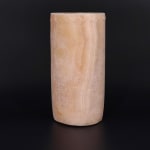Predynastic Cylinder Beaker , 4000 BC - 3000 BC
Alabaster
20.7 x 10.2 cm
8 1/8 x 4 in
8 1/8 x 4 in
CC.57
Further images
-
(View a larger image of thumbnail 1
)

-
(View a larger image of thumbnail 2
)

-
(View a larger image of thumbnail 3
)

-
(View a larger image of thumbnail 4
)

-
(View a larger image of thumbnail 5
)

-
(View a larger image of thumbnail 6
)

-
(View a larger image of thumbnail 7
)

-
(View a larger image of thumbnail 8
)

-
(View a larger image of thumbnail 9
)

-
(View a larger image of thumbnail 10
)

-
(View a larger image of thumbnail 11
)

Predynastic Egyptian artisans produced an imaginative variety of stone vessels, which are among the emblematic artefacts of the period. Stone vessels like this were not designed for everyday use; pottery...
Predynastic Egyptian artisans produced an imaginative variety of stone vessels, which are among the emblematic artefacts of the period. Stone vessels like this were not designed for everyday use; pottery vessels were far more disposable and better suited to domestic contexts. Instead, stone vases are almost exclusively related to the realm of the afterlife, being placed in tomb contexts. Some may have contained foodstuffs or other necessities for the eternal nourishment of the deceased, but they also had ritual significance in their own right. In the afterlife, the deceased needed analogues of the possessions they used in daily life if they were to enjoy the same benefits after death. Stone vessels were therefore a more robust and permanent replacement for the fragile pottery of daily life. Even empty, these vessels ensured the continued survival of the soul. The craftsmanship required to produce such stone vases was significant. The outside of the vessel would be roughly carved, before the artisan bored out the middle of the vessel with a bow-drill. Once this laborious task was complete, the vessel was smoothed with different grades of stone.
This tall cylinder beaker has a flat round bottom, and rises up straight upwards; there is a band of decoration consisting of a single wavy line in low relief. The wavy line probably represented water, due to its similarity to the later hieroglyph. The fact that there is no rim may indicate that a small flat lid was intended to be used with this vessel. The vessel is carved from alabaster, and the artist has sensitively used the rich banding of the alabaster to his advantage. The alabaster is carved thinly enough for light to shine through, giving the piece a luminous quality. It is unclear what this vessel was used for. Similar beaker-shapes with lids, usually with a tapering shape, are commonly called ‘cosmetic vessels’, though the size of this example is perhaps too large for a high-value commodity like cosmetics. Of course, this vessel was most likely designed for a funerary context. In this case, it is possible that a giant cosmetics vessel would express the wish of the deceased to be richly blessed with the necessities of life in the Other World.
The permanence of stone, and the longevity it bestowed on the tomb’s owner, was characteristic of Egyptian funerary practice. In this vessel we see an early example of the beliefs and practices for which the Egyptians would later become famous. These vessels became so emblematic of the artisan’s work that the later hieroglyph for ‘craftsman’ represented one of the boring tools used to hollow out the centre.
This tall cylinder beaker has a flat round bottom, and rises up straight upwards; there is a band of decoration consisting of a single wavy line in low relief. The wavy line probably represented water, due to its similarity to the later hieroglyph. The fact that there is no rim may indicate that a small flat lid was intended to be used with this vessel. The vessel is carved from alabaster, and the artist has sensitively used the rich banding of the alabaster to his advantage. The alabaster is carved thinly enough for light to shine through, giving the piece a luminous quality. It is unclear what this vessel was used for. Similar beaker-shapes with lids, usually with a tapering shape, are commonly called ‘cosmetic vessels’, though the size of this example is perhaps too large for a high-value commodity like cosmetics. Of course, this vessel was most likely designed for a funerary context. In this case, it is possible that a giant cosmetics vessel would express the wish of the deceased to be richly blessed with the necessities of life in the Other World.
The permanence of stone, and the longevity it bestowed on the tomb’s owner, was characteristic of Egyptian funerary practice. In this vessel we see an early example of the beliefs and practices for which the Egyptians would later become famous. These vessels became so emblematic of the artisan’s work that the later hieroglyph for ‘craftsman’ represented one of the boring tools used to hollow out the centre.










